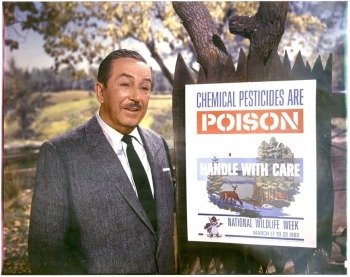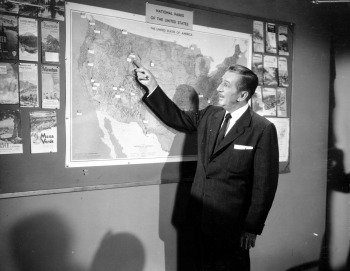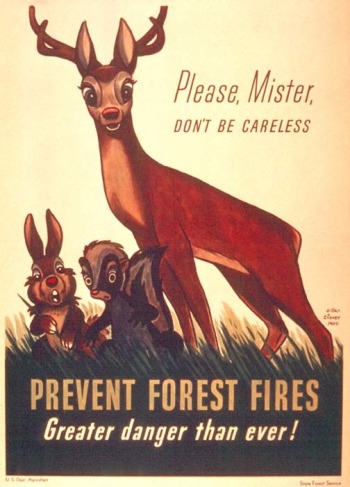
In recognition of the power of millions of individual actions, today's Earth Day 2011 is organized around A Billion Acts of Green®: Personal, organizational and corporate pledges to live and act sustainably. In observation of Earth Day, Disney scholar Douglas Brode offers this except from his book, From Walt to Woodstock: How Disney Created the Counterculture.
In 1962, [Rachel Carson’s] book Silent Spring belatedly brought “the basic irresponsibility of an [ever more] industrialized technological society toward the natural world” to the public’s attention.1 Hardly by coincidence, President Kennedy responded by creating a special panel of his Science Advisory Committee to study long-term problems created by uncontrolled chemical spraying, setting ecology into place as a significant sixties issue. Carson was hardly the only person hammering home such ideas; similar concepts were advanced by social critic Paul Goodman, German philosopher Herbert Marcuse, and anarchist-ecologist Murray Bookchin (aka Lewis Herber) among others. All proceeded from a single concept, considered radical at the time: “The history of life on earth has been a history of interaction between living things and their surroundings,” a natural balance now endangered by human meddling.2

However extremist this sounded in 1962, the theory had already been advanced and popularized by Disney. Bambi—re-released every seven years, the case with each Disney animated classic before the home video era—offered an ecology-oriented, anti-hunting statement to one set of young people after another. They would eventually emerge as a more environmentally oriented generation than had ever existed in mainstream America. Precisely how much Disney influenced sixties youth is impossible to say. No question, though, that they did experience the movies, the most basic element making up our popular culture, at an extremely impressionable age. The same would be true of Disney’s upcoming nature films, containing, like Bambi, a vividly rendered and “prescient message with their warnings about the environmental dangers of human invasion of the natural world.”3Disney’s own statements reveal his firm belief that a new generation, weaned on his films, could avoid the mistakes of its elders as to nature, as well as the betrayal of the previous generations own primal sympathy:
“An adult has lost the sense of play he once had. He’s the victim of civilization. The spontaneity of animals? You find it in children, but it’s gradually trained out of them.”4

The True-Life Adventures, beginning in 1950 [sic], proceeded from a slightly different perspective than Bambi, since the first modern ecologists had done their work. Disney’s self-ordained if unstated mission was to take such radical findings, previously directed to the country’s miniscule intellectualized reading audience, and popularize them by incorporating such concepts into crowd-pleasing entertainments. In this manner, Disney could educate the mass audience without its ever realizing that a propagandizing process was taking place. More than one nature film ends with narrator Winston Hibler explaining that enlightened individuals among us had begun approaching nature as a helpful partner rather than a dangerous adversary. Though he lived out most of his life during the twentieth century’s first half, Disney rejected the abiding conventional wisdom of his time. In its place he offered a sensibility that would not come to fruition until the late 1960s, at least partly as a result of his harnessing commercial entertainment to radicalize his all but captive audience.
Excerpted from From Walt to Woodstock: How Disney Created the Counterculture by Douglas Brode. © 2004 by The University of Texas Press. Used with permission.
Douglas Brode is a playwright, screenwriter, and journalist who teaches cinema studies at the Newhouse School of Public Communications at Syracuse University. He has written more than twenty books on film and media.
NOTES: 1. Paul Brooks, Foreword to the 1987 edition of Rachel Carson, Silent Spring (Boston: Houghton Mifflin, 1987), p. xii; 2. Rachel Carson, Silent Spring, p.5; 3. Steven Watts, The Magic Kingdom: Walt Disney and the American Way of Life (Boston: Houghton Mifflin, 1997), p. 305; 4. Dave Smith, ed., Walt Disney: Famous Quotes (Lake Buena Vista, FL: Kingdom Editions, 1994), p. 4.
[Images above: 1) Walt communicates the dangers of chemical pesticides, 1963. © Disney. 2) Walt espouses the benefits and wonders of the National Park System. © Disney. 3) The fire prevention campaign of the United States Forest Service began in 1942 with Bambi characters; in 1944 they were succeeded by Smokey Bear. © Disney.]
